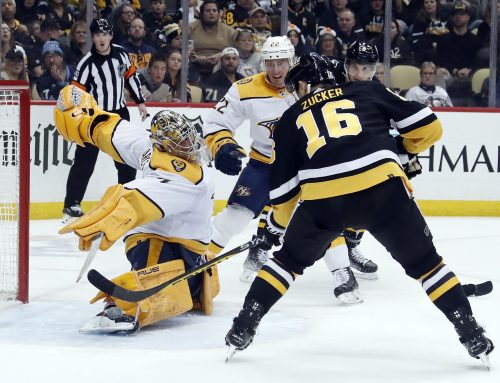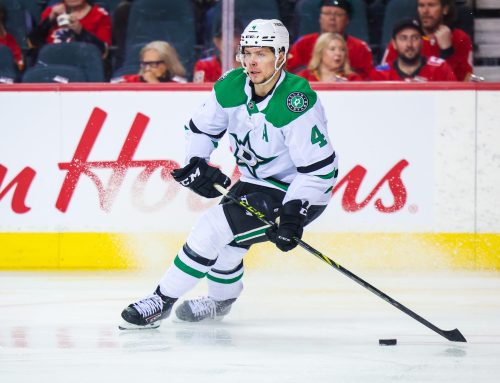
We’re into August now, and that means the annual Capped Column Buy/Sell feature will be running starting next week (where from each team one player to buy-low on, and one player to sell-high on are profiled).
In the meantime, we had news of a large extension drop on Monday morning, as Andrei Vasilevskiy put pen to paper on a deal with Tampa Bay that has him under their control until the summer of 2028 – he is the only player currently signed for that many years.
Some of the reactions to this deal have been mixed. Over on the forums, the reaction was largely on the positive side, but on Twitter and other platforms, there were plenty that were preaching about the contract being too much for a goalie. Can there really be a price at which a 25-year-old goalie coming off a spectacular season and a Vezina win, is overpaid? If so, where is the line, and when is it more valuable to overpay for a top tier starter, versus paying a middling amount for a middle of the pack goalie? Let’s see if we can sort that out.
****
Goalie Tiers
The best way to split up goalies into tiers is to use the best list we already have at our disposal: The Top 100 Keeper League Goaltenders – June 2019.
Vasilevskiy is number one, no surprises there. He is part of a two-man tier zero and is one of only sever goalies above the wide tier-two. He is in some elite company and will continue to reside in that top tier likely for the next five-seven years at minimum. Moving down the list, tier two includes 17 goalies, and tier three jumps us outside of the full-time starters with another 19. For the sake of this exercise, let’s keep the goalies at the four levels: The top handful, the other all-star level starters, the above average netminders, and the rest.
At any one time, the top handful of the goalies in the game can make the difference in turning a bubble team into a division contender and going from a division contender to a Stanley Cup favourite. Meanwhile, if we stick with the tiers that there are only enough above-average starters to cover half the teams in the NHL (that math checks out) then the other half of the league will be brought down by the goalies from the leftover pile.
*
Goalie Cap Allotment
With goaltenders usually taking up two of the 23 spots on an NHL roster, that means 8.7% of money spent should go to the goalies (though perhaps more if we were really to dive into how much sway they can have on a game… alas, that’s for another article). Assuming teams spend about $80 million on average of the $81.5 million cap this season, that means the average total goalie cap hit per team would be about $7 million. What we actually have, is a nice number of $6.69 million per team being spent on goalies per team (65 currently under contract).
Let’s throw some statistics basics out here to satisfy the math nerds. For those of us that didn’t do so well in their entry university statistics course, here’s the basic rule we’re using: Any data set will have 68% of the data points within one standard deviation, and 95% of the data points within two standard deviations. With the current $6.7 million per team, and a standard deviation of about $2.5 million, that means 68% of the NHL teams should be spending between $3.2 – $9.2 million on their goalies. This upcoming season, there are three teams that will be paying a large chunk more than that, in Chicago, Montreal, and Florida. Moving up to the 95th percentile of goalie cap hits, we see only the Montreal Canadiens past that threshold, in part due to the highest paid goalie in the league, Carey Price.
Next year, Vasilevskiy and perhaps Braden Holtby will be paid enough to knock their teams up into this elite group, but at the same time, that will bring the averages up, and we may still only see one or two teams in that 95th percentile range.
*
Mixing Maths
That lines up well with the breakdown of the tiers for goalies as well, as in the 95th percentile, we have two goalies, Frederik Anderson, and Vasilevskiy. Now the top two goalies don’t match up to the top three spending teams here, however we can’t expect NHL general managers to be able to understand this kind of math.
What this means, is that there should be two or three pairs of goalies in the NHL at any one time being paid in the 95th percentile, and there will be two or three individual goalies worthy of being paid in the 95th percentile. Vasilevskiy will be making less than two other goalies next season (assuming Holtby doesn’t also pass him), and deserves to be in that range, while the others: Price, and Sergei Bobrovsky, are close to providing value, but not quite.
Ideally, your top two most valuable goalies in the league would be earning around $10.2 million, while the backup earns around $1.5 million, meaning a combined $12.7 million for the team total. For the above average goalies, you would want to be paying no more than $9.2 million for your set, meaning a maximum of around $7.2 for the above average goalies. Using those numbers, and the tier system in the top-100 rankings, you should be able to quickly sort out whether your goalie is vastly overpaid, or underpaid. For one last season, Vasilevskiy will be the king of the underpaid group.
****
The Newest Devil
Nikita Gusev (LW/RW) – New Jersey Devils
Cap Hit: $4,500,000 with two years remaining
Everyone keeps trying to compare this signing to the Blackhawks bringing in Artemi Panarin, however what I see is something closer to Evgenii Dadonov joining the Panthers (the contract is eerily similar too). Very few players in the world can make the kind of impact Panarin did, and betting against it will mean you are right a lot more often than not.
Dadonov had played a few games in the NHL years ago. When he came back, he joined a team that had a hole in their top-six forward group, and saw a good chunk of time with the top powerplay unit. Expect the similar things from Gusev, who would have had what could be considered a successful season if he matches the 65-points scored by Dadonov in 2017-2018. The rookie season 77 by Panarin are a little out of reach, especially when considering Gusev’s PNHLe has ranged between 49 and 57 over the last few years in the KHL.
****
Other quick hits:
– Evan Rodrigues getting $2 million on a two-year deal from an arbitrator looked like a lot to me. If I’m the team going up against any of the other cases left such as Rocco Grimaldi, Joel Edmundson, etc. I would be willing to budge a little on my price just to avoid getting a price that’s one and a half times what I would expect from arbitration.
– David Rittich is not getting more than 45 starts this season with his new contract. More likely he ends up closer to 35.
– The one goaltending case where it may not be necessary to “follow the money”, is with the Rangers. They are still technically rebuilding, so they won’t have an issue seeing what they have in Georgiev, and he was the better goalie for many stretches last season. Without a clear favourite in the Metro this season, there may be room for the Rangers to ride a hot hand to a playoff spot.
– After trading Condon, the Sens finally have zero players on their roster making more salary next year than their cap hit. Meanwhile the Lightning clear their books from any LTIR use and should be solely focused on the Brayden Point and Adam Erne extensions now.
****
All salary info courtesy of capfriendly, all statistics are pulled from FrozenTools.
You can find me on Twitter @alexdmaclean.
****
Previous Capped articles:





 FLA
FLA CHI
CHI NYR
NYR PIT
PIT L.A
L.A COL
COL CAR
CAR MIN
MIN STL
STL CBJ
CBJ NSH
NSH
